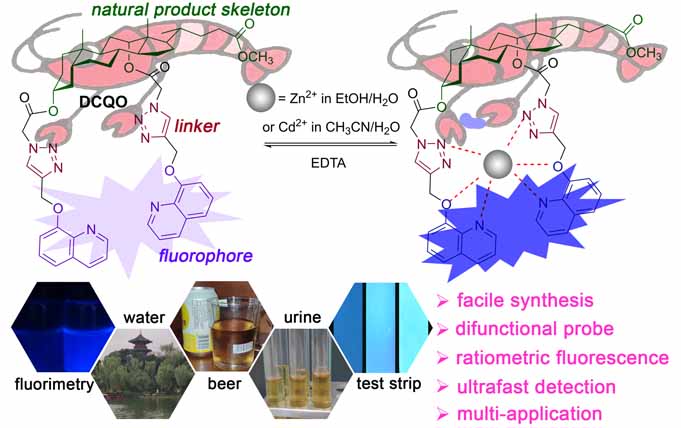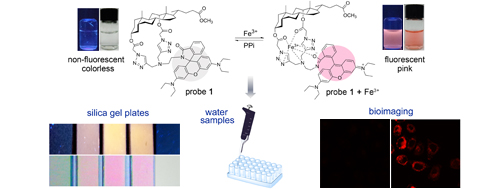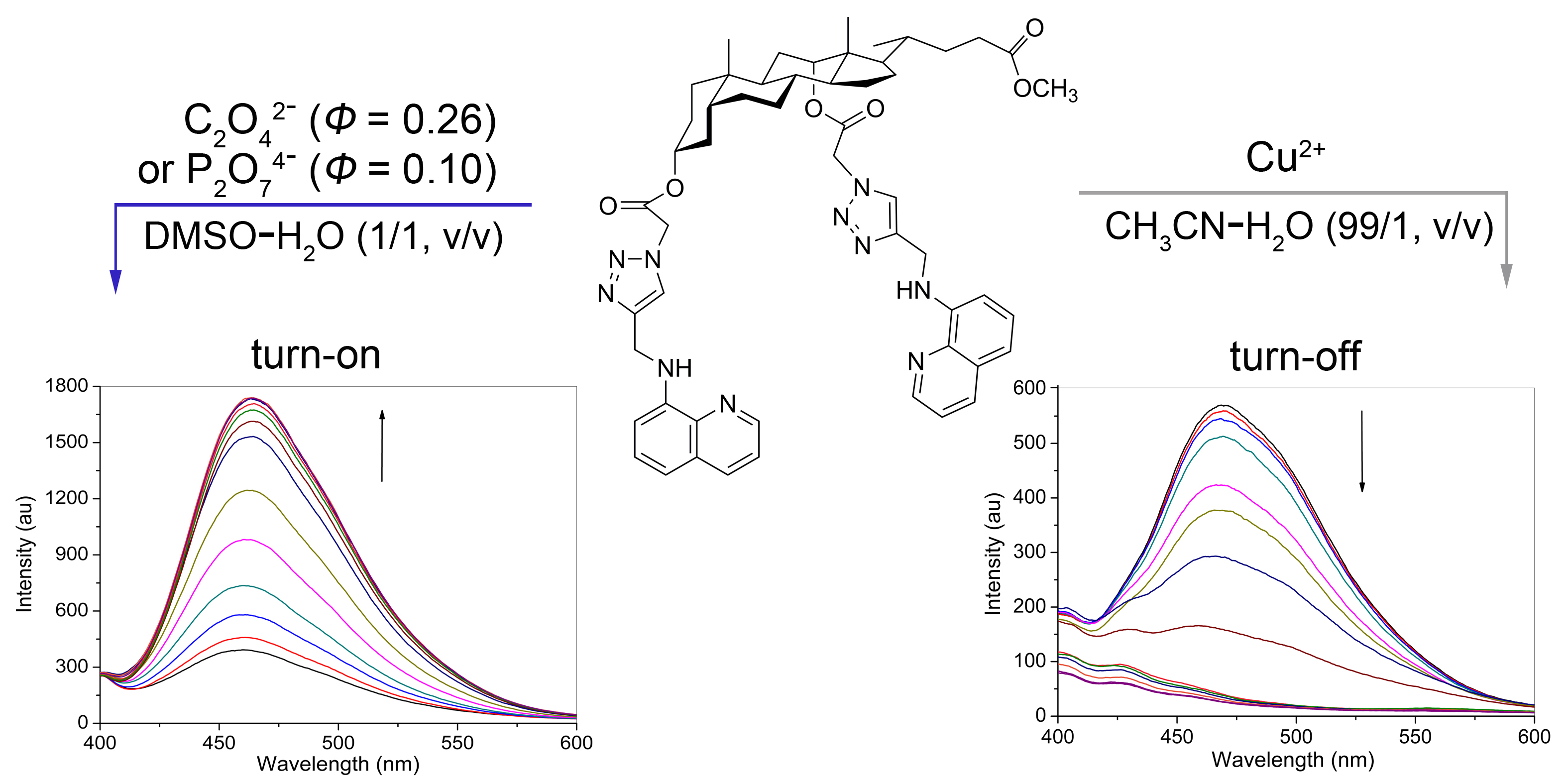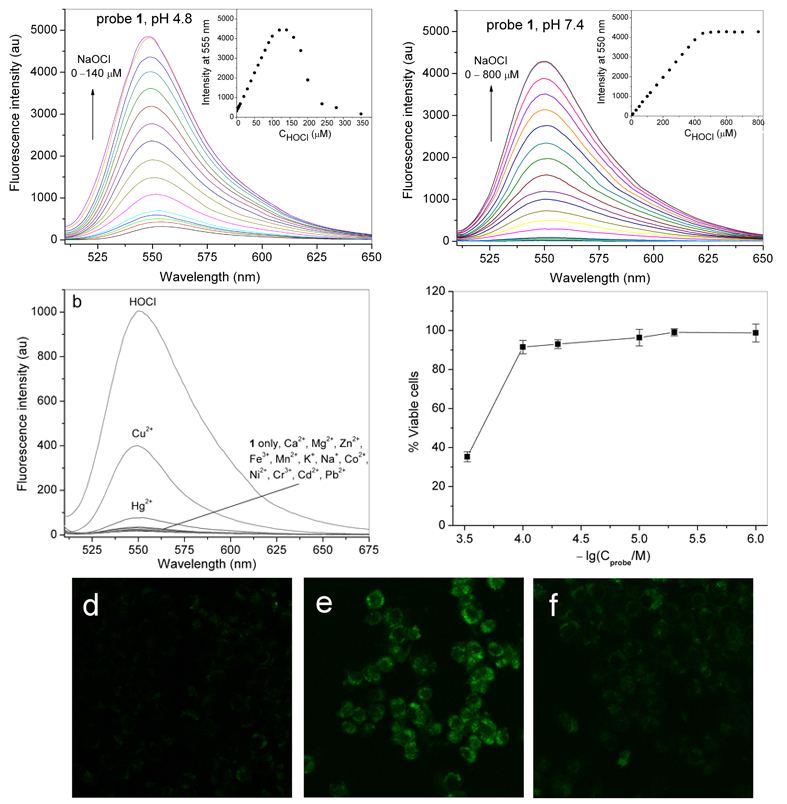Zhen Zhang, Yuan Zou, Jihua Liu. A single 8-hydroxyquinoline-appended bile acid fluorescent probe obtained by click chemistry for solvent-dependent and distinguishable sensing of zinc(II) and cadmium(II). LUMINESCENCE, 2024, 39, e4610.

Construction of fluorescent probes for zinc ion (Zn2+) and cadmium ion (Cd2+) is significant for the safety of humans. However, the discriminating recognition of Zn2+ and Cd2+ by a single probe remains challenging owing to their similar properties. Herein, a novel deoxycholic acid derivative containing 8-hydroxyquinoline fluorophore has been facilely synthesized through click chemistry to form a clamp-like probe. Using its perfect bonding cavity from 1,2,3-triazole and quinoline, this molecule showed favorable solvent-dependent fluorescent responses and distinguished Zn2+ and Cd2+ in different solvents. In ethanol aqueous solution, it displayed good selectivity and ratiometric fluorescence to Zn2+ with 30 nm spectroscopic red-shifts. In acetonitrile aqueous solution, it exhibited good selectivity and ratiometric fluores- cence to Cd2+ with 18 nm spectroscopic red-shifts. Moreover, the unique microstructural features of the probe in assembly were used to reflect its recognition processes. Due to its merits of low detection limit and instant response time, the probe was utilized for sensing Zn2+ and Cd2+ in water, beer and urine with high accuracy. Meanwhile, this probe served as a handy tool and was employed to obtain inexpensive test strips for the prompt and semiqualitative analysis of Zn2+ and Cd2+ with the naked eye.
Huanhuan Song, Zhen Zhang*. A quinoline-based ratiometric fluorescent probe for discriminative detection of Zn2+ and Cd2+ with different binding modes, and its Zn2+ complex for relay sensing of pyrophosphate and adenosine triphosphate. Dyes and Pigments, 2019, 165, 172.

A new and simple quinoline-based fluorescent probe for discriminative sensing of Zn2+ and Cd2+ has been synthesized by inserting an amide group into the 8-aminoquinoline fluorophore and a propargylamine chelating site. This easily-available chemosensor displayed selective and distinct ratiometric fluorescence responses to Zn2+ in almost totally water solution through its amide tautomer binding form, and to Cd2+ in CH3CN aqueous medium through its imidic acid tautomer binding form, respectively. Moreover, the in situ prepared probe 1–Zn2+ complex could act as a relay fluorescent sensor selectively toward pyrophosphate (PPi) and adenosine 5’-triphosphate (ATP) anions via further complexation. Thus, with good specificity, low detection limits and fast response time, a highly efficient fluorescence platform for simultaneous multi-analyte detection has been developed by using the uncomplicated single molecule. Finally, this multi-functional probe was applied successfully for analysis of all the target ions in the tap water sample and on test paper strips, and bioimaging of Zn2+ in mung bean sprouts with low phytotoxicity.
Zhen Zhang*, Chengquan Deng, Huanhuan Song. A novel rhodamine-based turn-on fluorescent probe for dual detection of Cr3+ and Cu2+ with solvent-dependent binding properties. Inorganic Chemistry Communications, 2018, 95, 56.

A new and simple 8-aminoquinoline–rhodamine conjugate-based fluorescent probe was constructed. This chemosensor displayed simultaneously significant fluorescent enhancement for Cr3+ in CH3CN solution and Cu2+ in ethanol solution with high selectivity and sensitivity. The solvent-dependent binding modes provided facile and efficient dual-analyte fluorescent detection. Besides, the concomitant differentiable colorimetric changes with Cr3+ and Cu2+ in CH3CN medium contributed easy and sensitive analysis of both cations by absorbance measurements and naked eyes. Finally, the probe was applied to detect Cr3+ and Cu2+ on silica gel plates.
Zhen Zhang*, Chengquan Deng, Yuan Zou, Lei Chen. A novel fluorescent and colorimetric probe for cascade selective detection of Fe(III) and pyrophosphate based on a click generated cyclic steroid-rhodamine conjugate. Journal of Photochemistry and Photobiology A: Chemistry, 2018, 356, 7.

A novel fluorescent and colorimetric probe containing deoxycholic acid and rhodamine moieties was developed by click chemistry, and its cascade selective detection of ferric ion (Fe3+) and pyrophosphate (PPi) was investigated in details by spectral measurements. The probe displayed turn-on orange fluorescence and colorless to pink color change upon binding with Fe3+ by reversibly forming the metal complex and opening the spirolactam ring of rhodamine. Through a tandem ligand exchange, PPi with higher affinity for Fe3+ removed the metal from the complex and restored the spectral signal of the probe. The experimental results suggested that this novel molecule could serve as an efficient and economical dual signal chemosensing system for cascade bi-target analysis of Fe3+ and PPi with high selectivity, low detection limits and fast response time. Notably, this bi-functional probe also showed excellent performances in monitoring Fe3+ and PPi on silica gel plates, in water samples and living cells.
Zhen Zhang*, Yuan Zou, Chengquan Deng. A novel and simple solvent-dependent fluorescent probe based on a click generated 8-aminoquinoline–steroid conjugate for multi-detection of Cu(II), oxalate and pyrophosphate. RSC Advances, 2017, 7, 14742.

张祯*, 邓成权, 郭添, 孟列素. 一种罗丹明类次氯酸荧光探针的合成与分析应用. 分析测试学报, 2014, 33, 7.
金励铭, 张祯*, 赵晓佳. 一种结构新颖的对肼和pH双响应的荧光探针的合成和性质. 第十届全国化学生物学学术会议, 2017, 武汉, 国内会议.
邹媛, 邓成权, 赵晓佳, 张祯*. 一种新颖的溶剂依赖型荧光探针的合成及性质研究. 中国化学会第30届学术年会, 2016, 大连, 国内会议.
Zhen Zhang*, Tian Guo, Liesu Meng. A Rhodamine Hydrazide Fluorescent Probe for Selective Detection of Hypochlorous Acid in Living Cells. 第八届全国化学生物学学术会议, 2013, 上海, 国内会议.
Zhen Zhang, Mingyu Niu, Yong Ju, Yufen Zhao. Studies on the DNA binding and cleavage activity of a synthesized polyamide containing dipeptide Ser-His. Science in China Series B–Chemistry, 2007, 50, 806.
张祯, 巨勇, 赵玉芬. 利用1,3-偶极环加成反应合成胆甾二聚体. 有机化学, 2007, 27, 64.
Yan Li, Zhen Zhang, Yong Ju, Changqi Zhao. Design, synthesis and antitumor activity of dimeric bile acid-amino acid conjugates. Letters in Organic Chemistry, 2007, 4, 414.
Qiang Yin, Zhen Zhang, Yufen Zhao. Studies of interaction between a new synthesized minor-groove targeting artificial nuclease and DNA. Spectrochimica Acta Part A–Molecular and Biomolecular Spectroscopy, 2007, 66, 904.
Qiang Yin, Zhen Zhang, Yufen Zhao. Studies on a novel minor-groove targeting artificial nuclease: Synthesis and DNA binding behavior. Chemical Research in Chinese Universities, 2007, 23, 44.
Qiang Yin, Zhen Zhang, Yufen Zhao. DNA binding and cleavage property of pyrenyl-mac rocyclic polyamine conjugate. Chinese Chemical Letters, 2006, 17, 1185.
Qiang Yin, Zhen Zhang, Yufen Zhao. A highly-selective probe for detection of zinc(II) in neutral aqueous solution. Journal of Chemical Research–S, 2006, (3), 160.







